Andżelika Mirska, University of Warsaw
Relevance of the Practice
The management problem of metropolitan areas is one of the most crucial challenges for Polish local governments and for the Polish State in the 21st century. The solution to this problem may involve: (i) grassroots cooperation initiatives between local government units, or (ii) top-down solutions, i.e. legal regulations prepared by the central government and parliament.
The Tricity is a special area in northern Poland, situated directly on the Baltic Sea, and consisting of three neighboring cities Gdansk, Gdynia and Sopot as separate urban communes (gminas) with county (powiats) status. They constitute the metropolitan area core.
The functioning of the two economically strong cities (Gdansk and Gdynia) in close proximity results from historical conditions. From the 11th century, Gdansk has evolved into the commercial and port center in this area. Gdynia’s development began only in the 1920s. It was caused by the establishment of the Free City of Danzing(Wolne Miasto Gdańsk) and Poland’s difficult access to the Baltic Sea. The Polish Government decided to build a port in Gdynia, leading to the dynamic city development. Sopot is situated between them, playing primarily a part of a tourist center.

Metropolization processes occur naturally in this area. The Tricity is a type of polycentric urban agglomeration.[1] A problem for the coherent area management is the growing functional associations between Gdynia, Gdansk and Sopot, and their surroundings including neighboring cities, communes (gminas) and counties (powiats). Since the restoration of local government in Poland in 1990, local politicians have been aware of the need for cooperation between communes (gminas). Since 1999, counties (powiats) have been functioning in this area (second level of local government). Moreover, the voivodeship self-government has been operating in this area since 1999 (the third level of self-government, which is responsible, inter alia, for regional rail transport).
Since 1990s, the grassroots initiatives occurred, regarding cooperation between local governments. Gdansk was the initiator of cooperation between local governments, and Gdynia presented its own ideas. The Association Gdansk Metropolitan Areawas the most significant,[2] established in 2011 at the Mayor of Gdansk initiative, consisting of 41 local governments, and the Association Metropolitan Forum of the Local Government Units Heads (NORDA) established by the Mayor of Gdynia, composed of 20 representatives of local governments.[3]
The cooperation between Gdansk and Gdynia seemed to be impossible. However, an agreement was reached in 2015 and the Gdansk Metropolitan Area association was transformed into the Association Gdansk-Gdynia-Sopot Metropolitan Area. The Association henceforth consociates local governments of the entire metropolis and is an institution that officially represents them considering the Government and the European Commission. The association enables joint implementation of decisions, such as investment planning, providing bus and rail connections, and promoting communes (gminas) and counties (powiats) as one organ.
Certainly, the establishment of one common organization was accelerated by the fact that since February 2014, the office of the Association Gdansk MetropolitanArea has acted as the headquarters of the Association of ‘Integrated Territorial Investments (ITI)’[4] which is a new instrument for metropolitan cooperation financed by EU funds. Currently, the Gdansk-Gdynia-Sopot Metropolitan Area serves in that capacity.[5]
Description of the Practice
The Association Gdansk-Gdynia-Sopot Metropolitan Area is a voluntary association of 59 local government units with over 1.6 million inhabitants.
The area of the Association Gdansk-Gdynia-Sopot Metropolitan Area includes:
- 3 cities with county (powiats) status (Gdansk, Gdynia, Sopot);
- 11 municipalities (urban communes);
- 13 urban-rural communes (gminas);
- 24 rural communes (gminas);
- 8 counties (powiats).
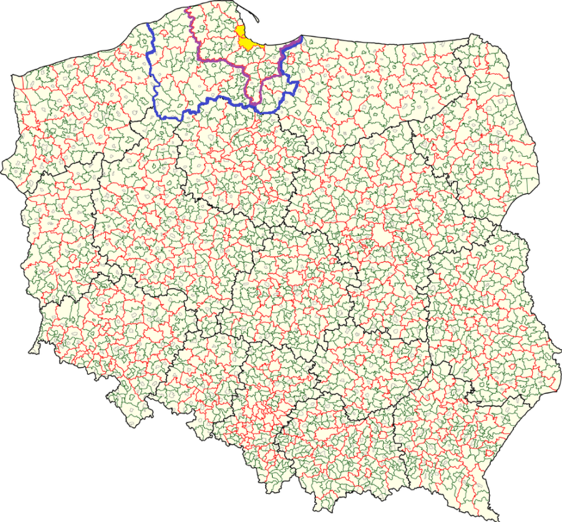

The Gdansk-Gdynia-Sopot Metropolitan Area consists of 51 communes (gminas). Communes (gminas) are the first, primary level of local government in Poland. Additionally, counties (powiats), the second level of local government in Poland, are members of the Association. Under the subsidiarity principle, they help communes (gminas) perform local tasks of ‘supragmina’ character. Counties (powiats) cover several communes (gminas).
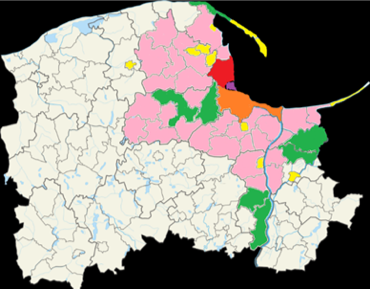
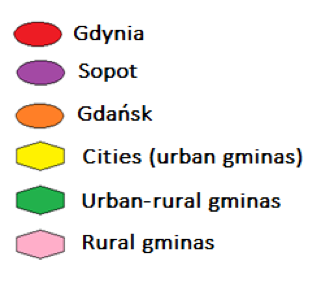
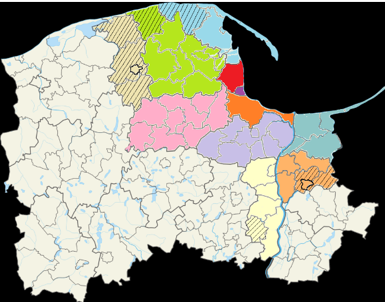
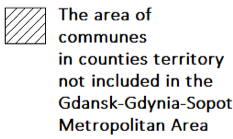
The Gdansk-Gdynia-Sopot Metropolitan Area comprises 8 counties (powiats). However, not all communes (gminas) from these counties (powiats) joined the Association. The commune does not have to take any action in order not to become a member of the association. The activity is needed if the commune wants to join the association. Then, the decision to join the association is made by the representative authority, who adopts a resolution.[9]
The map above presents communes (gminas) on a territory of five counties (powiats), not acceding to the Association. These include the peripheral communes (gminas), remote from the metropolitan area. Thus, the boundaries of the Gdansk-Gdynia-Sopot Metropolitan Area are different depending on whether we are considering communes (gminas) or counties (powiats). Furthermore, it should be noted that Gdańsk, Gdynia and Sopot are classified as the cities status with county (powiat) rights.
The Association’s statute provides for so-called ‘supporting members’ of the Association. Any natural or legal person declaring financial, material or substantive assistance in achieving the objectives of the association may become a supporting member. Supporting members have neither passive nor active voting rights in the association.[10] Currently, these include the University of Gdansk and the various economic operators, such as Gdansk Lech Walesa Airport, the Gdansk Heat Generators (Gdańskie Przedsiębiorstwo Energetyki Cieplnej Sp. z o.o.).
The association has legal personality and operates through the following bodies:
- the General Assembly;
- the Council;
- the Board;
- the Audit Committee.
The general assembly is the highest authority in the Gdansk-Gdynia-Sopot Metropolitan Area and is attended by all local government units affiliated to the association. The local government units’ mayors are the representatives from each local government. The meetings are held at least once a year. One very important point is that the votes of the participants of the general assembly are equal. Each has a single vote whether they are a city with close to half a million inhabitants like Gdansk or if they are a small rural municipality with tree thousand residents. The most important competences of the general assembly include adopting the Association’s activity program, adopting and introducing changes to the statute, the association council election and granting discharge for its activities.
The council is the authority that sets out and verifies strategic development directions of the Gdansk-Gdynia-Sopot Metropolitan Area. It is democratically elected by the general assembly. The council consists of a minimum of 6 and a maximum of 12 members. The term of office is equal to the term of office of local government units’ authorities. The association council competences include electing members of the management board, approving draft resolutions of the general assembly submitted by the management board, including the draft budget.
The association is led by the association board (1-3 people) which is selected by the council. The board is the executive authority and represents the association and is accountable for its work to the council. The board functions are performed professionally and its members are compensated for their tasks.
The audit committee is the control and internal supervision authority. The audit committee consists of 3 to 5 people elected by the general meeting.[11]
Assessment of the Practice
The Gdansk-Gdynia-Sopot Metropolitan Area is a voluntary association of local governments, whose activities are financed primarily from membership fees. The history of the Association’s formation presents the difficulty in creating grassroots cooperation initiatives. The issue of financing is always a problem. The communes (gminas) are concerned about abandoning performing tasks for their inhabitants in order to pay the membership fee. It may be negatively assessed by the inhabitants. However, by joining the Association, it is possible to build, for instance, a communication infrastructure connecting the commune (gminas) with the center of the metropolitan area. Under the conditions existing in Poland, funds from the European Union (EU) are undoubtedly an incentive to create such associations. Additionally, it concerns the Gdansk-Gdynia-Sopot Metropolitan Area. The office of the association has acted as the headquarters of the Association of Integrated Territorial Investments (ITI). As part of ITI cooperation, 167 projects are implemented with a total value of PLN 1.97 billion, of which PLN 1.07 billion come from EU funds.[12] The main financing source of Integrated Territorial Investments in Poland is 16 ‘Regional Operational Programs’. They were negotiated between 16 voivodship self-governments (regional level in Poland) and the European Commission.
What is more, other opportunities are sought by the association to increase the financing sources of its activities. The intention of local governments is the top-down establishment of a new territorial unit of a metropolitan feature. In this case, the Metropolitan Union Upper Silesian and Zagłębie Metropolis is an example, established in 2017 by act of the Polish Parliament and a regulation of the central government.[13] If such a territorial unit was created, it would receive additional funds from the Polish State budget. A draft law on the Metropolitan Union Gdansk-Gdynia-Sopot creation was prepared by the Gdansk-Gdynia-Sopot Metropolitan Areain 2020.This draft was submitted to the Senate of the Republic of Poland, the second chamber of the Polish Parliament. On this basis, the Senate prepared a draft law, which has been submitted to the Sejm, the first chamber of the Polish Parliament.[14]
Regardless of expectations for the top-down establishment of the Metropolitan Union Gdansk-Gdynia-Sopot Metropolitan Area, the association undertakes intensive activities for the metropolitan area development. A number of documents have been prepared, including the ‘Strategy of the Gdańsk-Gdynia-Sopot Metropolitan Area until 2030’. Network management is the primary strategy assumption. It includes the cooperation of local governments with the social sector, business, central government, scientific and research institutions. The position of small rural governments is particularly emphasized in order to gain better access to the resources of the metropolis by belonging to the Association. The innovation and position reinforcement in the European and global metropolitan system is also the objective of an action.[15]
References to Scientific and Non-Scientific Publications
—— ‘Strategy of the Gdańsk-Gdynia-Sopot Metropolitan Area until 2030’ (Gdansk-Gdynia-Sopot Metropolitan Area Association 2015) <https://www.metropoliagdansk.pl/upload/files/Strategia_OM%20G-G-S%20do%20roku%202030.pdf>
Czepczyński M, ‘The Making of the Gdańsk Metropolitan Region. Local Discourses of Powers, Identities and Hopes’ (2014) 33 Quaestiones Geographicae 57 Gajewski R, ‘The Grounds for Metropolitan Cooperation. A Case Study of the Gdańks-Gdynia-Sopot Metropolitan Area’ (2018) 31 STUDIA MIEJSKIE 53
[1] Currently, the notions of agglomeration is not present in the Polish legal system. An agglomeration – densely built-up area of mutually related settlement units developed by concentration processes. The term ‘conurbation’ may also be used in this context: the conurbation—a territorial coalescence of two or more sizable cities whose peripheral zones have grown together, see ‘Conurbation’ (Britannica, undated) <https://www.britannica.com/topic/conurbation> accessed 21 September 2021.
[2] See the website of the Gdansk-Gdynia-Sopot Metropolitan Area, <https://www.metropoliagdansk.pl/>.
[3] See the website of NORDA, <www.nordaforum.pl/>.
[4] For more information, see report section 3.3. on Integrated Territorial Investment.
[5] ‘ZIT w województwie pomorskim’ (Obszar Metropolitalny Gdańsk Gdynia Sopot, 2020) <https://www.metropoliagdansk.pl/zit/zit-w-wojewodztwie-pomorskim/> accessed 10 January 2021.
[6] Own elaboration, with the map taken from Aotearoa <https://pl.wikipedia.org/wiki/Wikipedysta:Aotearoa/mapy>.
[7] Own elaboration, with the map taken from Aotearoa <https://upload.wikimedia.org/wikipedia/commons/thumb/9/99/Pomorskie_mapa_administracyjna.png/238px-Pomorskie_mapa_administracyjna.png>.
[8] Own elaboration, with the map taken from Aotearoa <https://upload.wikimedia.org/wikipedia/commons/thumb/9/99/Pomorskie_mapa_administracyjna.png/238px-Pomorskie_mapa_administracyjna.png>.
[9] Art 12 of the Statute of The Gdańsk-Gdynia-Sopot Metropolitan Area Association, passed on 13 April 2015, amended on February 2020, <https://www.metropoliagdansk.pl/upload/files/Statut(2).pdf> accessed 10 January 2021.
[10] Art 13 of the Statute of The Gdańsk-Gdynia-Sopot Metropolitan Area Association, passed on 13 April 2015, amended on February 2020 <https://www.metropoliagdansk.pl/upload/files/Statut(2).pdf> accessed 10 January 2021.
[11] Chapter VI of the Statute of The Gdańsk-Gdynia-Sopot Metropolitan Area Association, passed on 13 April 2015, amended on February 2020 <https://www.metropoliagdansk.pl/upload/files/Statut(2).pdf > accessed 10 January 2021.
[12] ‘7 lat owocnej współpracy w ramach Zintegrowanych Inwestycji Terytorialnych’ (Obszar Metropolitalny Gdańsk Gdynia Sopot, 12 February 2021) <https://www.metropoliagdansk.pl/metropolitalne-wiadomosci/7-lat-owocnej-wspolpracy-w-ramach-zintegrowanych-inwestycji-terytorialnych/> accessed 11 January 2021.
[13] For more information, see report section 4.3. on the Functioning of the Metropolitan Union ‘Upper Silesian-Zagłębie Metropolis’.
[14] Sejm, ‘Senacki projekt ustawy o związku metropolitalnym w województwie pomorskim’ (Sejm, 1 March 2021) <https://www.sejm.gov.pl/sejm9.nsf/PrzebiegProc.xsp?id=0C36111687C506F9C12585F400379047> accessed 1 March 2021.
[15] ‘Strategy of the Gdańsk-Gdynia-Sopot Metropolitan Area until 2030’ (Gdansk-Gdynia-Sopot Metropolitan Area Association 2015) <https://www.metropoliagdansk.pl/upload/files/Strategia_OM%20G-G-S%20do%20roku%202030.pdf> accessed 2 January 2021.
